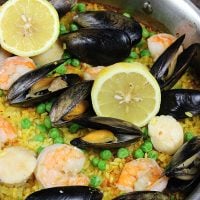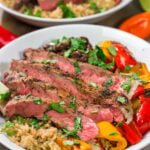Classic Spanish Seafood Paella
This Classic Spanish Seafood Paella is a classic Spanish recipe. It’s a delicious and unique way to mix up dinners at home!
This post may contain paid links. For more information, please see our disclosure policy.
 Until a couple of weeks ago, I had never tried making paella at home. I’d had paella in several restaurants, and I always thought it was a delicious entree. So I decided the time had come to give paella a shot at home!
Until a couple of weeks ago, I had never tried making paella at home. I’d had paella in several restaurants, and I always thought it was a delicious entree. So I decided the time had come to give paella a shot at home!
If you aren’t familiar with paella, its a classic Spanish dish that features the unique flavor of saffron. I’ve even heard paella described as the unofficial national dish of Spain. One of the nice things about paella is that you can go in many different directions using a similar base of ingredients. I’ve seen chicken and chorizo paella, seafood paella, and also several mixed paellas, which include a combination of chicken and other land game along with various types of seafood.
No matter the choice of meat, the cooking style is always similar…and paella always features saffron along with tasty olive oil. Saffron is a unique spice in a variety of ways. First, rather than a ground spice, saffron is typically found as loose strands. These strands are actually dried stigmas from a specific variety of crocus flower.
When my wife and I went to Italy a couple years ago for our honeymoon, we visited a vineyard that also produced saffron. The owner of the vineyard described how the crocus would bloom for only a couple of weeks each year, and they would go out early in the morning each day to harvest the strands by hand before the flowers wilted from the heat of the sun. No wonder saffron is one of the most expensive spices in the world! But the good thing is that saffron is a very potent spice, and most recipes call for a very small amount.
 The proper way to cook paella is over an open flame using a unique pan called a paellera. These round, shallow pans are often very large in diameter, and the finished paella is traditionally served at the table directly from the paellera. (I don’t actually own a paellera, so I used a large sauté pan, and it worked great. If I begin to make paella more often at home, then I will certainly consider picking up a paellera!)
The proper way to cook paella is over an open flame using a unique pan called a paellera. These round, shallow pans are often very large in diameter, and the finished paella is traditionally served at the table directly from the paellera. (I don’t actually own a paellera, so I used a large sauté pan, and it worked great. If I begin to make paella more often at home, then I will certainly consider picking up a paellera!)
Another unique feature of paella is the layer of crispy, toasted rice at the bottom of the pan. This rice layer, called a socarrat, is created by increasing the heat at the very end of the cooking process until the rice actually begins to crackle. As you can imagine, the socarrat features intense, delicious flavors, and it is the most sought-after portion of the finished paella.
For my first homemade paella, I decided to go with a classic seafood version. There is something quite appealing and enticing about combining so many different varieties of seafood in one dish! And you can certainly be creative with your choice of seafood here. I used some of my favorite types of seafood, but I’ve also seen lobster, calamari, and clams used in paella. Be creative!

Spanish Seafood Paella
Ingredients
- 4 cups chicken broth divided
- ¼ tsp saffron
- 3-4 Tbsp olive oil
- 6 oz. scallops
- 8 oz. medium shrimp, peeled, deveined, shells reserved
- ⅓ cup diced onions
- 2 tsp minced garlic
- 1 medium roma tomato finely diced
- 1½ cups medium-grain white rice
- 8 oz. mussels
- ⅓ cup frozen peas
- 2 lemons for garnishing
Instructions
- Place all 4 cups of chicken broth in a medium saucepan and heat over medium heat until boiling. Reduce the heat to a simmer, add the shrimp shells, and continue simmering for 10 minutes.
- Pour the stock through a fine-mesh strainer. Add the saffron, stir gently, and allow the stock to rest off the heat. Discard shrimp shells.
- Meanwhile, heat the oil on medium-high in a paellera or large saute pan. Add the shrimp and scallops and cook until done, about 2-3 minutes. Remove shrimp and mussels and set aside.
- Using the same paellera or large saute pan, reduce the heat to medium and add the onion and garlic. Cook until onion begins to soften, about 5-6 minutes. Add the tomato, stir, and continue to cook for another 16-18 minutes, stirring often. (Note: If the mixture begins to burn, add a tbsp of the broth.)
- Heat the broth back to a simmer in the saucepan. Add the rice to the paellera or saute pan and cook for 1-2 minutes over medium heat. Increase the heat to medium-high, add 3 cups of the broth, and slightly shake the pan to ensure that the rice is evenly distributed. Continue to cook for 8-10 minutes. (Note: Once the rice is added, do not stir the paella again!)
- Reduce heat to medium-low, add the mussels, and continue cooking until the rice is fully cooked. (If all of the liquid in the pan is absorbed before the rice is done cooking, add enough of the reserved broth to prevent rice from burning.)
- Continue cooking over medium-low heat until the rice is fully cooked and all of the liquid has been absorbed, about 8-10 minutes. Add the shrimp and scallops to the pan, but do not stir.
- Increase the heat to medium-high and cook until bottom layer of rice begins to crackle, about 2 minutes. (The rice will smell fragrant, but if it beings to smell burnt, then remove from heat!)
- Remove paella from heat and allow to rest for 5 minutes before serving.
- Serve with lemon wedges directly from the pan.





How may servings???
So many internet recipes don’t put the serving size. Drives me crazy. LOL
Hey Pat! Serving size is difficult as it is so relative, but this sized paella should serve about 4. Also, while paella can be eaten as leftovers, it’s far better when eaten fresh! I hope you enjoy!!
When do you add the peas?
Hey Ashley! Oops, I completely forgot to mention the peas in the instructions. Sorry about that! The peas should be added with about 5 minutes left (so part of the way through Step 7). Let me know if you have any other questions. Enjoy!!